by Bruce Wells | Jan 22, 2024 | This Week in Petroleum History
January 22, 1861 – Pennsylvania Refinery produces Kerosene –
The first U.S. multiple-still refinery was brought on-stream one mile south of Titusville, Pennsylvania, by William Barnsdall, who had drilled the second successful well after Edwin Drake’s first U.S. oil discovery.
Barnsdall and partners James Parker and W.H. Abbott spent about $15,000 to build six basic stills for refining kerosene. Much of the equipment was purchased in Pittsburgh and shipped up the Allegheny River to Oil City. The refinery produced two grades of kerosene, white and the less the expensive yellow.
January 22, 1910 – Standard Oil of California strikes Oil
Standard Oil Company of California (Socal) drilled its first successful oil well, a gusher in Kern County that initially produced 1,500 barrels of oil a day from the Midway-Sunset field, The discovery came after the 1906 merger of Pacific Coast Oil Company (see First California Oil Well) and Standard Oil Company of Iowa to create Socal.
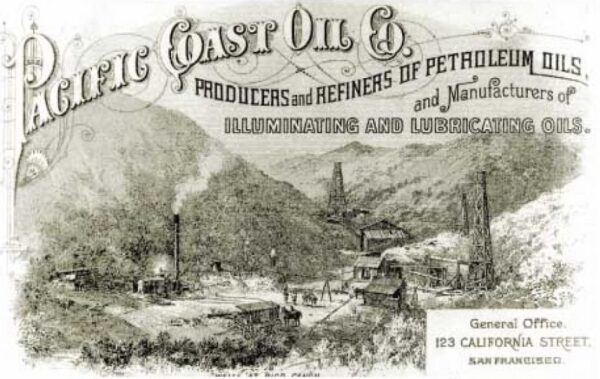
Standard Oil Company of California (Socal) began in 1879 as the Pacific Coast Oil Company, and in 1981 renamed Chevron. Image courtesy Chevron.
The new company needed more oil reserves after it had “stepped up its marketing efforts, particularly in gasoline sales, which nearly doubled between 1906 and 1910,” according to a company history. “Until now, Standard had left the hunt for oil to others.”
The U.S. Supreme Court in 1911 ordered Socal separated from its parent, Standard Oil Company of New Jersey. After absorbing Standard Oil of Kansas in 1961 and making other acquisitions, the California company in 1984 rebranded as Chevron, headquartered in San Ramon.

January 23, 1895 – Standard Oil closes Oil Exchanges
Standard Oil Company of New Jersey’s purchasing agency in Oil City, Pennsylvania, notified independent oil producers it would only buy their oil at a price “as high as the markets of the world will justify” — and not “the price bid on the oil exchange for certificate oil.”
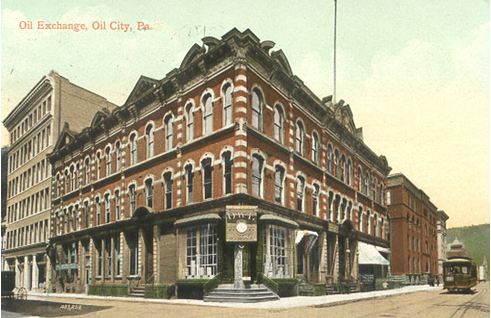
The Oil City, Pennsylvania, Oil Exchange incorporated in 1874. By 1877, it was the third largest financial exchange in the United States.
Oil City’s exchange had become the third largest financial exchange of any kind in America, behind New York and San Francisco. But with the Standard Oil Company buying 90 percent of oil production and setting its own price for certificates, all other oil exchanges soon closed.
Learn more in End of Oil Exchanges.
January 23, 1957 – Wham-O launches a New Petroleum Product
One of the earliest mass-produced products made from plastic, the “Frisbee” was introduced by Wham-O Manufacturing Company of California. The toy originated in 1948 when a company called Partners in Plastic sold its “Flyin’ Saucers” for 25 cents each. In 1955, Richard Knerr and Arthur “Spud” Melin’s Wham-O bought the rights.
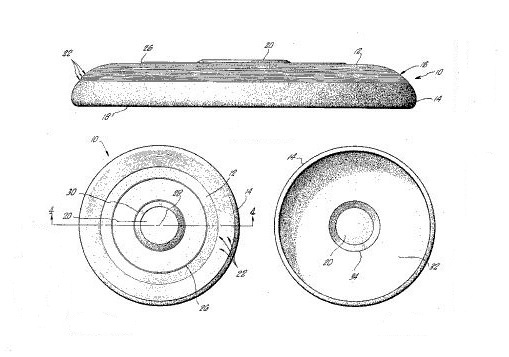
U.S. patent detail of a 1967 polyethylene plastic Frisbee.
The Wham-O founders discovered that Phillips Petroleum had invented a high-density polyethylene (called Marlex). They used the new plastic to meet phenomenal demand for manufacturing Frisbees – and Hula Hoops beginning in 1958.
Learn more in Petroleum Product Hoopla.

January 23, 1991 – Gulf War brings World’s Largest Oil Spill
The world’s largest oil spill began in the Persian Gulf when Saddam Hussein’s retreating Iraqi forces opened pipeline valves at oil terminals in Kuwait. About 11 million barrels of oil would cover an area extending 101 miles by 42 miles and reaching five inches thick in some places.
Iraqi soldiers sabotaged Kuwait’s main supertanker loading pier, dumping millions of gallons of oil into the Persian Gulf. By February, about 600 Kuwaiti wells had been set ablaze. It would take months to put out the well fires, with the last extinguished in early April 1991.
January 24, 1895 – Pure Oil Company founded by Independent Producers –
To counter Standard Oil Company’s market dominance, Pennsylvania oil producers, refiners, and pipeline operators organized what would become a major Chicago-based oil venture. Originally based in Pittsburgh, Pure Oil Company quickly grew into the second vertically integrated U.S. petroleum company after Standard Oil.
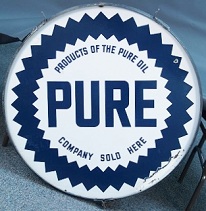
An Ohio firm adopted the old Pennsylvania name.
Beginning in early 1896, Pure Oil marketed its petroleum products by horse-drawn tank wagons in Philadelphia and New York — successfully competing with Standard Oil’s monopoly. The Ohio Cities Gas Company of Columbus acquired Pure Oil and in 1920 adopted the former Pennsylvania venture’s brand name.
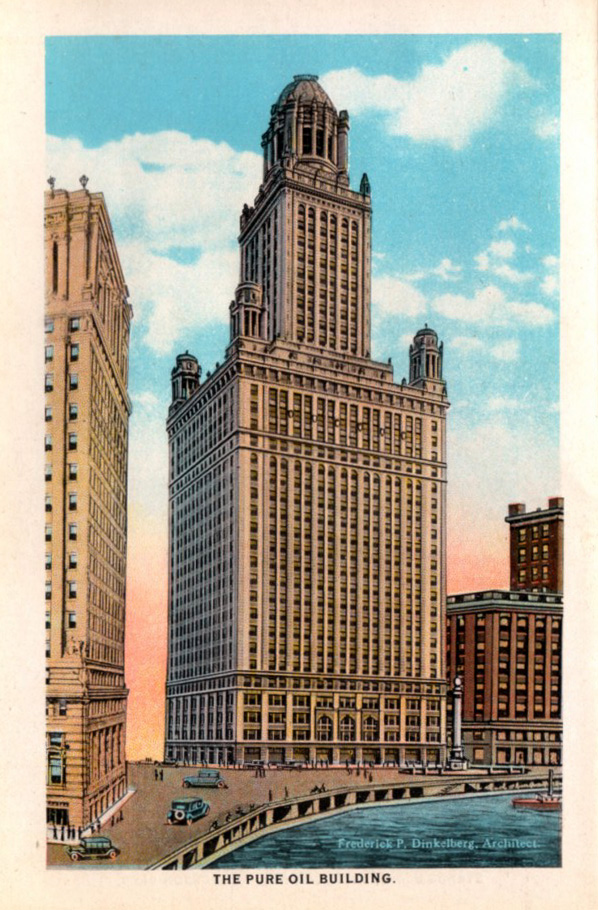
Pure Oil Company in 1926 moved into its new 40-story Chicago headquarters building at 35 East Wacker Drive.
With a new Chicago headquarters opened in 1926, Pure Oil began exploring offshore technologies within a decade. The company developed early freestanding drilling platforms in the Gulf of Mexico.

January 25, 1930 – North Texas Oil Producers form Association
After meeting in Wichita Falls to protest “the recent drastic price cut in crude oil, inaugurated by some of the major purchasing companies,” 50 independent producers organized the North Texas Oil and Gas Association. Other issues included seeking a tariff on foreign oil imports and stopping “hot oil” oilfield thefts. The association merged with the West Central Texas Oil & Gas Association in 1998 to become the Texas Alliance of Energy Producers.
January 26, 1931 – Third Well reveals Extent of East Texas Oilfield
As East Texas farmers struggled to survive the Great Depression, an oil discovery confirmed the existence of a massive oilfield. W.A. “Monty” Moncrief of Fort Worth completed the Lathrop No. 1 well, which produced 7,680 barrels of oil a day from 3,587 feet deep. Geologists at first thought a third oilfield had been found.
Moncrief’s discovery well was 25 miles north of the famous Daisy Bradford No. 3 well of October 1930, drilled by Columbus Marion “Dad” Joiner. It was 15 miles north of the Lou Della Crim No. 1 well, completed at Kilgore three days after Christmas 1930. The 130,000-acre East Texas oilfield would become the largest in the lower-48 states.
Learn more in Moncrief makes East Texas History.
January 28, 1921 – “Vaseline Well” erupts in Oklahoma
After reaching a depth of 3,710 feet, drillers of the W.C. Newman well near Lamar, Oklahoma, “hit into a strata of oil, the like of which never before, nor since has been found,” reported the Daily Oklahoman in a 1933 retrospective of the well, which “caused oil men to marvel then, as today, since it produces the same Vaseline-like content.”
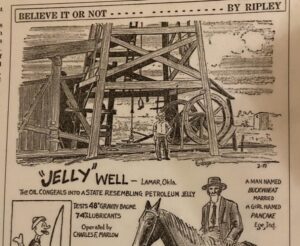
High-viscosity oil from the 1921 Oklahoma well was featured by the syndicated Believe It or Not by Ripley. Illustration courtesy Hughes County Historical Society Facebook Page.
The Hughes County well erupted a dark green oil that “turned into a brilliant yellow when it came into contact with the outside air” and sprayed 200 feet of a semi-solid mass that “hung like gum from the nearby fences, trees and other structures,” noted the newspaper.
“Ordinary pipelines would not carry the oil, so a special line, sandwiched between four steam pipes to heat the almost solid lubricant enabled it to flow to storage tanks,” the article added. Featured as the “jelly” well in the syndicated Believe it or Not by Ripley, by 1933 daily production of 350 barrels of the high-viscosity oil had declined to 15 barrels.
January 28, 1969 – Oil Spill at Santa Barbara, California
After drilling 3,500 feet below the Pacific Ocean floor, a Union Oil Company drilling platform six miles off Santa Barbara suffered a blowout. The accident spilled an estimated 100,000 barrels of oil into the ocean with some reaching southern California’s beaches, including Summerland — where early U.S. offshore petroleum history began in 1896 with wells drilled from piers.
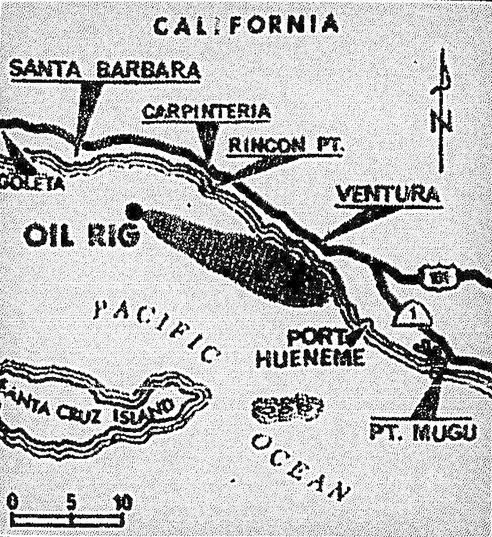
Beyond the 1969 Santa Barbara spill, marine scientists have noted California’s natural oil seeps continue to leak tons of petroleum every day.
The drilling crew had begun to retrieve pipe in order to replace a drill bit when the mud used to maintain pressure became dangerously low, causing a natural gas blowout, according to the University of California, Santa Barbara. The well, which was brought under control after 12 days, turned public opinion against offshore exploration and helped lead to creation of the Environmental Protection Agency (EPA) in December 1970.
Naturally occurring oil seeps in the Santa Barbara Channel have been significantly reduced by offshore oil production, according to “History of Oil in the Santa Barbara Channel,” a 2018 exhibit at the Santa Barbara Maritime Museum.
Learn more in Oil Seeps and the Santa Barbara Spill.
January 28, 1991 – Parker Rig No. 114 becomes Tourist Attraction
Among the biggest drilling rigs in the world, Parker Drilling Company’s Rig No. 114, was erected in a vacant lot in downtown Elk City, Oklahoma, after civic leaders realized that the massive rig, visible from I-40 and historic Route 66, could draw tourists. The Parker rig had once drilled deep wells for testing nuclear bombs.

Parker Rig No. 114 has welcomed visitors to Elk City, Oklahoma, since 1991. Photo by Bruce Wells.
In 1969, Parker Drilling signed a contract with the U.S. Atomic Energy Commission to drill a series of holes up to 120 inches in diameter and 6,500 feet deep in Alaska and Nevada. After the experiments, the company modified its rig to drill conventional wells that set records by reaching beyond four miles deep into the Anadarko Basin.
The 17-story Parker No. 114 today stands in downtown Elk City next to the former Casa Grande Hotel at the intersection of 3rd Street and Route 66. Casa Grande, which opened in 1928 to lodge the highway’s travelers, was added to the National Register of Historic Places in 1995. It also was once home to a natural history museum that included petroleum exhibits.
_______________________
Recommended Reading: Titan: The Life of John D. Rockefeller, Sr. (2004); Plastic: The Making of a Synthetic Century
(2004); Plastic: The Making of a Synthetic Century (1996); Against the Fires of Hell: The Environmental Disaster of the Gulf War
(1996); Against the Fires of Hell: The Environmental Disaster of the Gulf War (1992); The Black Giant: A History of the East Texas Oil Field and Oil Industry Skulduggery & Trivia
(1992); The Black Giant: A History of the East Texas Oil Field and Oil Industry Skulduggery & Trivia (2003); Slick Policy: Environmental and Science Policy in the Aftermath of the Santa Barbara Oil Spill (2018);. Your Amazon purchase benefits the American Oil & Gas Historical Society. As an Amazon Associate, AOGHS earns a commission from qualifying purchases.
(2003); Slick Policy: Environmental and Science Policy in the Aftermath of the Santa Barbara Oil Spill (2018);. Your Amazon purchase benefits the American Oil & Gas Historical Society. As an Amazon Associate, AOGHS earns a commission from qualifying purchases.
_______________________
The American Oil & Gas Historical Society (AOGHS) preserves U.S. petroleum history. Become an AOGHS annual supporting member and help maintain this energy education website and expand historical research. For more information, contact bawells@aoghs.org. Copyright © 2024 Bruce A. Wells. All rights reserved.
by Bruce Wells | Jan 16, 2024 | Petroleum Pioneers
When a Fort Worth independent producer drilled a January 1931 wildcat well in East Texas, he revealed the true extent of an oilfield discovered months earlier and many miles away.
W.A. “Monty” Moncrief and two partners completed the Lathrop No. 1 well on January 26, 1931. The Gregg County well produced 320 barrels of oil per hour (7,680 barrels a day) from a depth of 3,587 feet.
As the Great Depression worsened and East Texas farmers struggled to survive, this third well — far from two earlier discoveries — revealed what proved to be a giant oilfield, extending dozens of miles.
Moncrief, who had worked for Marland Oil Company in Fort Worth after returning from World War I, drilled in an area few geologists thought petroleum production a possibility. He and fellow independent operators John Ferrell and Eddie Showers thought otherwise.
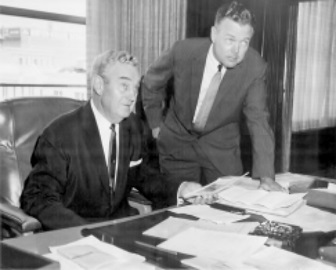
A circa 1960 photograph of W.A. “Monty” Moncrief and his son “Tex” in Fort Worth’s Moncrief Building.
The third East Texas well was completed 25 miles north of Rusk County’s already famous October 1930 Daisy Bradford No. 3 well drilled by Columbus Marion “Dad” Joiner northwest of Henderson (and southeast New London, site of a tragic 1937 school explosion).
Moncrief’s oil discovery came 15 miles north of the Lou Della Crim No. 1 well, drilled three days after Christmas, on “Mama” Crim’s farm about nine miles from the Joiner well.
At first, the distances between these “wildcat” discoveries convinced geologists, petroleum engineers (and experts at the large oil companies) the wells were small, separate oilfields. They were wrong.
Three Wells, One Giant Oilfield
To the delight of other independent producers and many small, struggling farmers, Moncrief’s Lathrop discovery showed that the three wells were part of a single petroleum-producing field — the largest ever found.
As a drilling boom exploded, further development revealed the “Black Giant” East Texas oilfield stretching 42 miles long and four to eight miles wide.

The region’s unique history is exhibited at the East Texas Oil Museum, which opened in 1980 at Kilgore College. Joe White, the founding director who retired in 2014, created a museum that houses the “authentic recreation of the oil discoveries and production in the early 1930s in the largest oilfield inside U.S. boundaries.”
After more than half a century of major discoveries, William Alvin “Monty” Moncrief died in 1986. His legacy has extended beyond his good fortune in East Texas.
The family exploration business established by Moncrief in 1929 would be led by sons W.A. “Tex” Moncrief Jr. and C.B. “Charlie” Moncrief, who grew up in the exploration business. In 2010, Forbes reported that 94-year-old “Tex” made “perhaps the biggest find of his life” by discovering an offshore field of about six trillion cubic feet of gas.
Moncrief Philanthropy
Hospitals in communities near the senior Moncrief’s nationwide discoveries, including a giant oilfield in Jay, Florida, revealed in 1970, and another in Louisiana, have benefited from his drilling acumen.
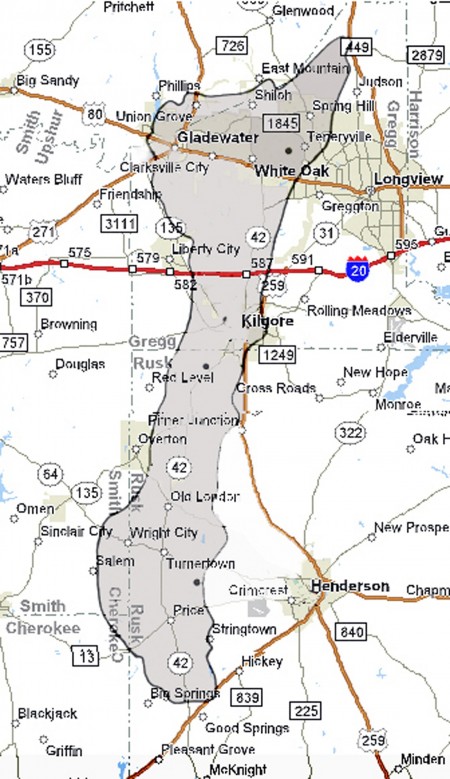
The 130,000-acre East Texas oilfield became the largest in the contiguous United States in 1930.
Moncrief and his wife established the William A. and Elizabeth B. Moncrief Foundation and the Moncrief Radiation Center in Fort Worth, as well as the Moncrief Annex of the All Saints hospital. Buildings in their honor have been erected at Texas Christian University, All Saints School, and Fort Worth Country Day School.
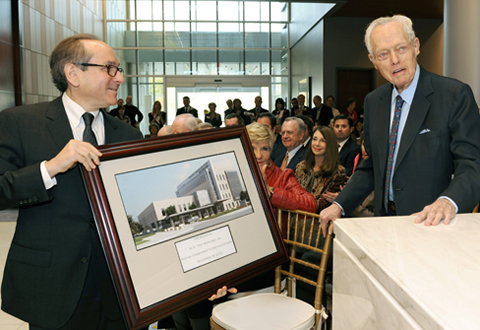
Dr. Daniel Podolsky in 2013 presented W.A. “Tex” Moncrief Jr. with a framed image of the new Moncrief Cancer Institute at the Fort Worth facility’s dedication ceremony.
Supported throughout the 1960s and 1970s by the Moncrief family, Fort Worth’s original Cancer Center, known as the Radiation Center, was founded in 1958 as one of the nation’s first community radiation facilities.
In 2013, the $22 million Moncrief Cancer Institute was dedicated during a ceremony attended by “Tex” Moncrief Jr. “One man’s vision for a place that would make life better for cancer survivors is now a reality in Fort Worth,” noted one reporter at the dedication of the 3.4-acre facility at 400 W. Magnolia Avenue.

Small investments from hopeful Texas farmers will bring historic results — and make Kilgore, Longview and Tyler boom towns during the Great Depression. Kilgore today celebrates its petroleum heritage.
Early Days in Oklahoma
Born in Sulphur Springs, Texas, on August 25, 1895, Moncrief grew up in Checotah, Oklahoma, where his family moved when he was five. Checotah was the town where Moncrief attended high school, taking typing and shorthand — and excelling to the point that he became a court reporter in Eufaula, Oklahoma.
To get an education, Moncrief saved $150 to enroll at the University of Oklahoma at Norman, where he worked in the registrar’s office. He became “Monty” after initiation into the Sigma Chi fraternity.

During World War I, Moncrief volunteered and joined the U.S. Cavalry. He was sent to officer training camp in Little Rock, Arkansas, where he met, and six months later married, Mary Elizabeth Bright on May 28, 1918.
Although sent to France, Moncrief saw no combat. The Armistice was signed before his battalion got to the front.
After the war, Moncrief returned to Oklahoma where he found work at Marland Oil, first in its accounting department and later in its land office. When Marland opened offices in Fort Worth in the late 1920s, Moncrief was promoted to vice president for the new division.
In 1929, Moncrief would strike out on his own as an independent operator. He teamed up with John Ferrell and Eddie Showers, and they bought leases where they ultimately drilled the successful F.K. Lathrop No. 1 well, which turned out to be the northernmost extension of the 130,000-acre East Texas field, largest ever in the lower-48 states.
_______________________
Recommended Reading: The Black Giant: A History of the East Texas Oil Field and Oil Industry Skulduggery & Trivia (2003); Early Texas Oil: A Photographic History, 1866-1936
(2003); Early Texas Oil: A Photographic History, 1866-1936 (2000); Your Amazon purchase benefits the American Oil & Gas Historical Society. As an Amazon Associate, AOGHS earns a commission from qualifying purchases.
(2000); Your Amazon purchase benefits the American Oil & Gas Historical Society. As an Amazon Associate, AOGHS earns a commission from qualifying purchases.
_______________________
The American Oil & Gas Historical Society (AOGHS) preserves U.S. petroleum history. Become an AOGHS supporting member and help maintain this energy education website and expand historical research. For more information, contact bawells@aoghs.org. Copyright © 2024 Bruce A. Wells. All rights reserved.
Citation Information – Article Title: “Moncrief makes East Texas History.” Authors: B.A. and K.L. Wells. Website Name: American Oil & Gas Historical Society. URL: https://aoghs.org/petroleum-pioneers/moncrief-oil. Last Updated: January 18, 2024. Original Published Date: January 25, 2015.
by Bruce Wells | Dec 23, 2023 | Petroleum Pioneers
Oil discovery on widow’s farm in East Texas confirmed existence of largest oilfield in the lower-48 states.
Some people said a gypsy told Malcolm Crim he would discover oil in East Texas three days after Christmas. Others claimed it was because his mother, Lou Della “Mama” Crim, was a pious woman.
On December 28, 1930, the exploratory well Lou Della Crim No. 1 began producing an astonishing 20,000 barrels of oil a day. Even then, few appreciated the true significance of the Rusk County well drilled by Mrs. Crim’s eldest son, Malcolm.

“Mrs. Lou Della Crim sits on the porch of her house and contemplates the three producing wells in her front yard,” notes the caption of this undated photograph about the wells that followed the historic 1930 discovery on her farm. Image courtesy Caleb Pirtle.
The region’s latest oil discovery brought headlines in Dallas newspapers, especially since Mrs. Crim’s well was about nine miles north of an earlier oil gusher on another widow’s farm. Everyone at first thought a second East Texas oilfield had been found.
In October, the Daisy Bradford No. 3 well of Columbus “Dad” Joiner had disproved experts who claimed East Texas contained no oil. Yet the distance between these discoveries convinced geologists — and major petroleum exploration companies — that the wells had found separate oilfields.
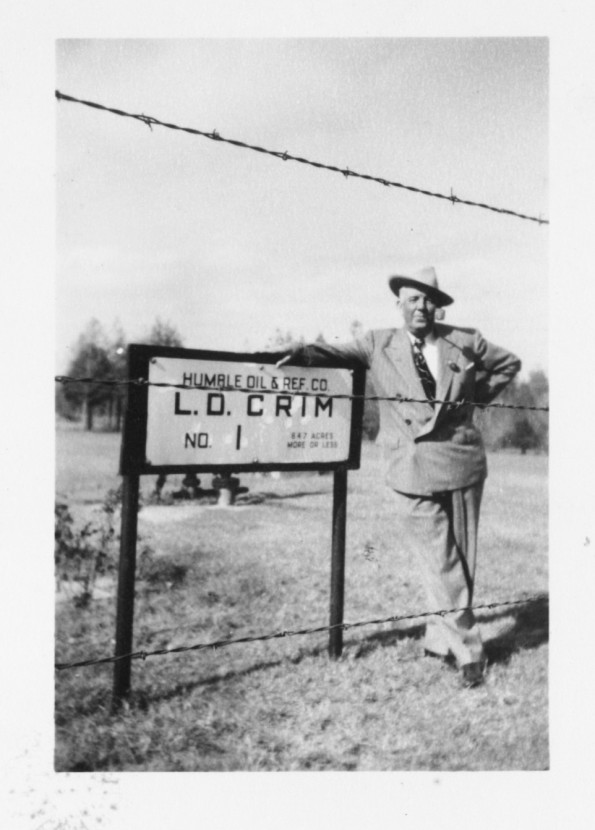
Malcolm Crim stands at site of his famous 1930 East Texas oil well, the Lou Della Crim No. 1, named after his mother.
(more…)
by Bruce Wells | Oct 30, 2023 | This Week in Petroleum History
October 30, 1894 – “Golden Rule” Jones invents a Better Sucker Rod –
Samuel M. Jones patented a sucker rod design for his Acme Sucker Rod Company, which he had founded in 1892 in Toledo, Ohio. With his “Coupling for Pipes or Rods,” Jones applied his oilfield experience in mechanics to solve the frequent and time-consuming problem of broken sucker rods. His innovation would soon make him a millionaire.
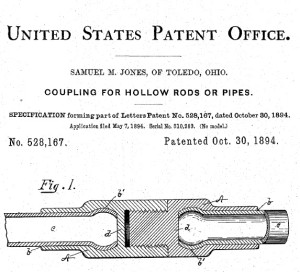
Samuel Jones had worked as a potboiler, pumper, tool dresser, blacksmith, and pipe layer.
Jones had worked in Pennsylvania’s oil region as a potboiler, pumper, tool dresser, blacksmith, and pipe layer. He became known as “Golden Rule” Jones by establishing a better workplace for employees at his factory, where he shortened the work day and started a revenue-sharing program.
Jones ran for Toledo mayor as a progressive Republican in 1887 and was elected. He was reelected three times and served until dying on the job in 1904.
Learn more in “Golden Rule” Jones of Ohio.

October 31, 1871 – Modern Refinery Method patented
Petroleum refining would become more efficient thanks to an invention by Henry Rogers of Brooklyn, New York, who patented an “apparatus for separating volatile hydrocarbons by repeated vaporization and condensation.”
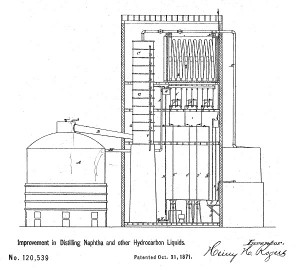
Henry Rogers improved the refining of kerosene.
Rogers introduced many elements of modern refineries, including “fractionating” towers that improved earlier processes of extracting kerosene by simple distillation in kettle stills.
“The apparatus which I use is, in many respects, similar to what is known as the column-still for distilling alcoholic spirits, but modified in all the details, so as to make it available for distilling oils,” Rogers noted in his 1871 patent application. More technological advancements would lead to giant refining operations like the Standard Oil of Indiana Whiting Refinery, which opened in 1889.
October 31, 1903 – Salt-Dome Oilfield discovered in Texas
One mile north of Batson, Texas, a discovery well drilled by W.L. Douglas’ Paraffine Oil Company produced 600 barrels of oil a day from a depth of 790 feet. A second well drilled two months later in the Batson field produced 4,000 barrels of oil a day from 1,000 feet deep. Many new ventures joined the drilling boom (see Buffalo Oil Company).
When combined with other newly discovered prolific salt-dome fields, Spindletop (1901), Sour Lake (1901), and at Humble (1905), “Batson helped to establish the basis of the Texas oil industry when these shallow fields gave up the first Texas Gulf Coast oil,” noted the Texas State Historical Association in 2010.

October 31, 1913 – First Paved U.S. Highway dedicated
Towns and cities nationwide celebrated the opening of the Lincoln Highway, the 3,389-mile-long “Main Street Across America” connecting Times Square in New York City to San Francisco’s Lincoln Park. The Lincoln Highway was the first national memorial dedicated to President Abraham Lincoln. In 1919, the Army Motor Transport Corps organized a transcontinental convoy to test vehicles and highlight the need for more paved roads.
October 31, 1924 – Former Olinda Oil Wells Pitcher plays Exhibition Game
Former oilfield worker Walter “Big Train” Johnson returned to his California oil patch roots for an exhibition game with Babe Ruth in Brea, California. Ruth swatted two home runs off the future Hall of Fame pitcher. Three decades earlier, Johnson had started his baseball career as a 16-year-old pitcher for the Olinda Oil Wells.
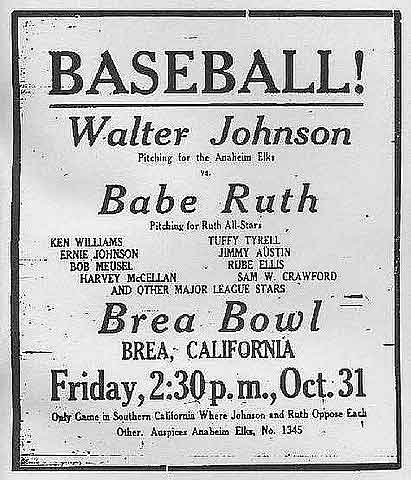
The former star player for the Olinda Oil Wells pitched against Babe Ruth in a 1924 exhibition game in nearby Brea.
Playing for the Washington Senators, the former roustabout became major league baseball’s all-time career leader in shutouts with 110. Many oilfield towns once fielded teams with names proudly reflecting their communities’ livelihood.
Learn more in Oilfields of Dreams – Gassers, Oilers, and Drillers Baseball Teams.
October 31, 1930 – Properties of Columbus “Dad” Joiner placed into Receivership
After it was learned 70-year-old wildcatter Columbus Marion “Dad” Joiner had oversold his East Texas oilfield leases in Rusk County, District Judge R.T. Brown placed the properties into receivership.
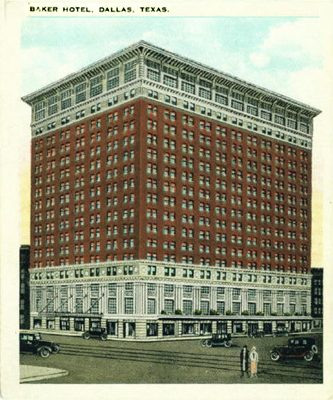
The Baker Hotel in Dallas was where Columbus “Dad” Joiner, discoverer of the East Texas oilfield, met with H.L. Hunt and sold Hunt 5,580 acres for $1.34 million. Built in 1925, the hotel was torn down in 1980.
With the field’s Daisy Bradford No. 3 and other wells tied up in conflicting claims, Joiner took refuge from creditors in the Baker Hotel in Dallas, where Haroldson Lafayette (H.L.) Hunt negotiated a $1.34 million deal with him for the discovery well and 5,580 acres of leases. In the 300 lawsuits and 10 years of litigation that followed, Hunt sustained every title.
November 1, 1865 – First Railroad Oil Tank Car arrives
The first of James and Amos Densmore’s innovative railroad oil tank cars arrived at the Miller Farm, four miles south of Titusville, Pennsylvania. The inventors would be awarded a U.S. patent on April 10, 1866, for their dual tank design.

Brothers Amos and James Densmore designed and built the first successful railroad tank cars used in the Pennsylvania oilfields in 1865. Photo courtesy Drake Well Museum.
The crude oil for the iron-banded wooden tanks on a flatcar was delivered by Samuel Van Syckle’s two-inch iron pipeline (another oil industry first) from the oilfield boom town at Pithole Creek. Oil from large storage tanks on the farm filled the Densmore tanks for the Oil Creek Railroad, which connected to lines reaching Pittsburgh, New York City, and other markets.
Learn more in Densmore Brothers Oil Tank Car.

November 2, 1902 – First Gas-Powered Locomobile delivered
Known for building luxury steam-powered automobiles, the Locomobile Company of America delivered its first gasoline-powered auto to a buyer in New York City. The company had hired Andrew Riker, a self-taught engineer and racecar driver, to create the four-cylinder, 12-horsepower vehicle, which sold for $4,000.

The four-cylinder gasoline engine of Locomobile “Old 16” racing car on display in the Henry Ford Museum, Dearborn, Michigan.
In 1908, a Locomobile “Old 16,” a four-cylinder, 16-liter, two-seater, won America’s first international racing victory — the Vanderbilt Cup at the Long Island Motor Parkway, one of the first paved parkways. The Locomobile Company would “reign supreme in the niche category of luxury American cars for decades,” according to Today in Connecticut History.
November 3, 1878 – Haymaker Natural Gas Well lights Pittsburgh
While drilling for oil in 1878, a well drilled by Michael and Obediah Haymaker erupted with natural gas from a depth of almost 1,400 feet. “Every piece of rigging went sky high, whirling around like so much paper caught in a gust of wind. But instead of oil, we had struck gas,” Michael Haymaker recalled.
Eighteen miles east of Pittsburgh, the out-of-control well in Murrysville, Pennsylvania, produced an estimated 34 million cubic feet of natural gas daily. It was considered the largest natural gas well ever drilled up to that time.
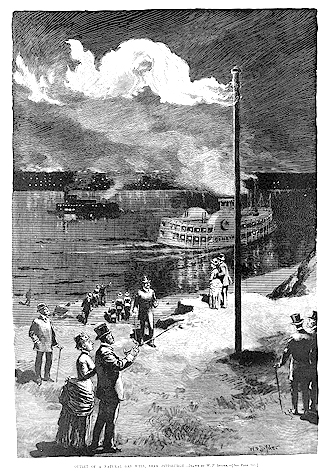
“A sight that can be seen in no other city in the world,” noted Harper’s Weekly in 1885.
Given oilfield technologies of the late 1880s, there was no way to cap the well and no pipeline to exploit commercial possibilities. The Haymaker well drew thousands of curious onlookers to a flaming torch that burned for 18 months and was visible miles away.
“Outlet of a natural gas well near Pittsburgh — a sight that can be seen in no other city in the world,” noted Harper’s Weekly. When finally brought under control, the Haymaker well provided inexpensive gas light to Pittsburgh for many years.
Learn more in Natural Gas is King in Pittsburgh.

November 3, 1900 – New York City hosts First U.S. Auto Show
America’s first gathering of the latest automotive technologies attracted thousands to New York City’s Madison Square Garden. Manufacturers presented 160 different vehicles and conducted driving and maneuverability demonstrations on a 20-foot-wide wooden track that encircled the exhibits.
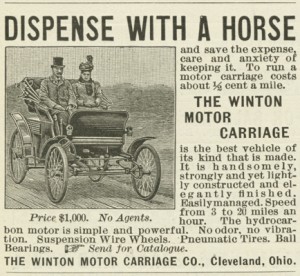
The Winton Motor Carriage of 1898 was the first American automobile advertisement.
Almost 50,000 visitors paid 50 cents each to witness autos driving up a 200-foot ramp to test hill-climbing power. The most popular models proved to be electric, steam, and gasoline…in that order. New Yorkers welcomed the new models as a way to reduce the 450,000 tons of manure and 15,000 horse carcasses that had to be removed from city streets every year.
Of the 4,200 automobiles sold in 1900, less than a thousand were powered by gasoline. But within five years, consumer preference established the dominance of gasoline-powered autos.
Learn more in Cantankerous Combustion — 1st U.S. Auto Show and First Gas Pump and Service Station.
_______________________
Recommended Reading: Holy Toledo: Religion and Politics in the Life of “Golden Rule” Jones (1998); The Bradford Oil Refinery, Pennsylvania, Images of America
(1998); The Bradford Oil Refinery, Pennsylvania, Images of America (2006); Early Texas Oil: A Photographic History, 1866-1936
(2006); Early Texas Oil: A Photographic History, 1866-1936 (2000); The Lincoln Highway: Coast to Coast from Times Square to the Golden Gate
(2000); The Lincoln Highway: Coast to Coast from Times Square to the Golden Gate (2011); Oil on the Brain: Petroleum’s Long, Strange Trip to Your Tank
(2011); Oil on the Brain: Petroleum’s Long, Strange Trip to Your Tank (2008); The Extraction State, A History of Natural Gas in America(2021); A History of the New York International Auto Show: 1900-2000
(2008); The Extraction State, A History of Natural Gas in America(2021); A History of the New York International Auto Show: 1900-2000 (2000). Your Amazon purchase benefits the American Oil & Gas Historical Society. As an Amazon Associate, AOGHS earns a commission from qualifying purchases.
(2000). Your Amazon purchase benefits the American Oil & Gas Historical Society. As an Amazon Associate, AOGHS earns a commission from qualifying purchases.
_______________________
The American Oil & Gas Historical Society (AOGHS) preserves U.S. petroleum history. Become an AOGHS annual supporting member and help maintain this energy education website and expand historical research. For more information, contact bawells@aoghs.org. Copyright © 2023 Bruce A. Wells. All rights reserved.
.
by Bruce Wells | Oct 2, 2023 | This Week in Petroleum History
October 2, 1919 – Future “Mr. Tulsa” incorporates Skelly Oil –
Skelly Oil Company incorporated in Tulsa, Oklahoma, with founder William Grove Skelly as president. He had been born in 1878 in Erie, Pennsylvania, where his father hauled oilfield equipment in a horse-drawn wagon.

Born near Pennsylvania’s early oilfields, independent oilman William Skelly’s company helped make Tulsa the “Oil Capital of the World.”
Skelly’s success in the El Dorado oilfield east of Wichita, Kansas, helped him launch Skelly Oil and other ventures, including Midland Refining Company, which he founded in 1917. As Tulsa promoted itself as “Oil Capital of the World,” Skelly became known as “Mr. Tulsa.”
Skelly served as president of Tulsa’s famous International Petroleum Exposition for 32 years until his death in 1957.

October 3, 1930 – East Texas Oilfield discovered on Widow’s Farm
With a crowd of more than 4,000 landowners, leaseholders, creditors, and spectators watching, the Daisy Bradford No. 3 remote wildcat well was successfully shot with nitroglycerin near Kilgore, Texas.

Spectators gathered on the widow Daisy Bradford’s farm near Kilgore, Texas, to watch the October 3, 1930, “shooting” of the discovery well of what proved to be the largest oilfield in the lower-48 states. Photo courtesy Jack Elder, The Glory Days.
“All of East Texas waited expectantly while Columbus ‘Dad’ Joiner inched his way toward oil,” explained historian Jack Elder in 1986. “Thousands crowded their way to the site of Daisy Bradford No. 3, hoping to be there when and if oil gushed from the well to wash away the misery of the Great Depression.” (more…)








(2004); Plastic: The Making of a Synthetic Century
(1996); Against the Fires of Hell: The Environmental Disaster of the Gulf War
(1992); The Black Giant: A History of the East Texas Oil Field and Oil Industry Skulduggery & Trivia
(2003); Slick Policy: Environmental and Science Policy in the Aftermath of the Santa Barbara Oil Spill (2018);. Your Amazon purchase benefits the American Oil & Gas Historical Society. As an Amazon Associate, AOGHS earns a commission from qualifying purchases.


















